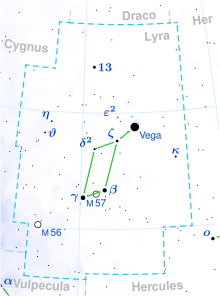Vega
| Observation data J2000.0
| |
|---|---|
| Constellation | Lyra |
Pronunciation
|
/ˈviːɡə/[1][2][3] or /ˈveɪɡə/[2] |
| Right ascension | 18h 36m 56.33635s[4] |
| Declination | +38° 47′ 01.2802″[4] |
| Apparent magnitude (V) | +0.026[5] (−0.02 – +0.07)[6] |
| Characteristics | |
| Evolutionary stage | Main sequence |
| Spectral type | A0Va[7] |
| U−B color index | 0.00[8] |
| B−V color index | 0.00[8] |
| Variable type | Delta Scuti[6] |
| Absolute magnitude (MV) | +0.582[10] |
| Details | |
Myr | |
LTT 15486[17] | |
| Database references | |
| SIMBAD | data |
Vega is the brightest
Vega has been extensively studied by astronomers, leading it to be termed "arguably the next most important star in the sky after the Sun".
Vega is only about a tenth of the age of the Sun, but since it is 2.1 times as massive, its expected lifetime is also one tenth of that of the Sun; both stars are at present approaching the midpoint of their main sequence lifetimes. Compared with the Sun, Vega has a lower abundance of elements heavier than helium.[13] Vega is also a variable star—that is, a star whose brightness fluctuates. It is rotating rapidly with a speed of 236 km/s at the equator. This causes the equator to bulge outward due to centrifugal effects, and, as a result, there is a variation of temperature across the star's photosphere that reaches a maximum at the poles. From Earth, Vega is observed from the direction of one of these poles.[22]
Based on observations of more
Nomenclature

Observation

Vega can often be seen near the zenith in the mid-northern latitudes during the evening in the Northern Hemisphere summer.[30] From mid-southern latitudes, it can be seen low above the northern horizon during the Southern Hemisphere winter. With a declination of +38.78°, Vega can only be viewed at latitudes north of 51° S. Therefore, it does not rise at all anywhere in Antarctica or in the southernmost part of South America, including Punta Arenas, Chile (53° S). At latitudes to the north of 51° N, Vega remains continuously above the horizon as a circumpolar star. Around July 1, Vega reaches midnight culmination when it crosses the meridian at that time.[31]
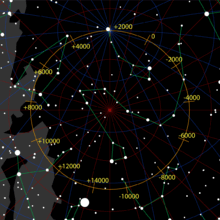
Each night the positions of the stars appear to change as the Earth rotates. However, when a star is located along the Earth's axis of rotation, it will remain in the same position and thus is called a
This star lies at a vertex of a widely spaced asterism called the Summer Triangle, which consists of Vega plus the two first-magnitude stars Altair, in Aquila, and Deneb in Cygnus.[30] This formation is the approximate shape of a right triangle, with Vega located at its right angle. The Summer Triangle is recognizable in the northern skies for there are few other bright stars in its vicinity.[35]
Observational history


The distance to Vega can be determined by measuring its parallax shift against the background stars as the Earth orbits the Sun. Giuseppe Calandrelli noted stellar parallax in 1805-6 and came up with a 4-second value for the star which was a gross overestimate.[40] The first person to publish a star's parallax was Friedrich G. W. von Struve, when he announced a value of 0.125 arcsecond (0.125″) for Vega.[41] Friedrich Bessel was skeptical about Struve's data, and, when Bessel published a parallax of 0.314″ for the star system 61 Cygni, Struve revised his value for Vega's parallax to nearly double the original estimate. This change cast further doubt on Struve's data. Thus most astronomers at the time, including Struve, credited Bessel with the first published parallax result. However, Struve's initial result was actually close to the currently accepted value of 0.129″,[42][43] as determined by the Hipparcos astrometry satellite.[4][44][45]
The brightness of a star, as seen from Earth, is measured with a standardized, logarithmic scale. This apparent magnitude is a numerical value that decreases in value with increasing brightness of the star. The faintest stars visible to the unaided eye are sixth magnitude, while the brightest in the night sky, Sirius, is of magnitude −1.46. To standardize the magnitude scale, astronomers chose Vega and several similar stars and averaged their brightness to represent magnitude zero at all wavelengths. Thus, for many years, Vega was used as a baseline for the calibration of absolute photometric brightness scales.[46] However, this is no longer the case, as the apparent magnitude zero point is now commonly defined in terms of a particular numerically specified flux. This approach is more convenient for astronomers, since Vega is not always available for calibration and varies in brightness.[47]
The
Photometric measurements of Vega during the 1930s appeared to show that the star had a low-magnitude variability on the order of ±0.03 magnitude (around ±2.8%[note 2] luminosity). This range of variability was near the limits of observational capability for that time, and so the subject of Vega's variability has been controversial. The magnitude of Vega was measured again in 1981 at the David Dunlap Observatory and showed some slight variability. Thus it was suggested that Vega showed occasional low-amplitude pulsations associated with a Delta Scuti variable.[51] This is a category of stars that oscillate in a coherent manner, resulting in periodic pulsations in the star's luminosity.[52] Although Vega fits the physical profile for this type of variable, other observers have found no such variation. Thus the variability was thought to possibly be the result of systematic errors in measurement.[53][54] However, a 2007 article surveyed these and other results, and concluded that "A conservative analysis of the foregoing results suggests that Vega is quite likely variable in the 1–2% range, with possible occasional excursions to as much as 4% from the mean".[55] Also, a 2011 article affirms that "The long-term (year-to-year) variability of Vega was confirmed".[56]
Vega became the first solitary
Physical characteristics
Vega's
Most of the energy produced at Vega's core is generated by the carbon–nitrogen–oxygen cycle (CNO cycle), a nuclear fusion process that combines protons to form helium nuclei through intermediary nuclei of carbon, nitrogen and oxygen. This process becomes dominant at a temperature of about 17 million K,[60] which is slightly higher than the core temperature of the Sun, but is less efficient than the Sun's proton–proton chain fusion reaction. The CNO cycle is highly temperature sensitive, which results in a convection zone about the core[61] that evenly distributes the 'ash' from the fusion reaction within the core region. The overlying atmosphere is in radiative equilibrium. This is in contrast to the Sun, which has a radiation zone centered on the core with an overlying convection zone.[62]
The energy flux from Vega has been precisely measured against standard light sources. At 5,480 Å, the flux density is 3,650 Jy with an error margin of 2%.
Using
Rotation
Vega has a rotation period of 12.5 hours,
When the radius of Vega was measured to high accuracy with an
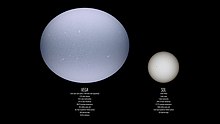
The pole of Vega—its axis of rotation—is inclined no more than five degrees from the line-of-sight to the Earth. At the high end of estimates for the
The local surface gravity at the poles is greater than at the equator, which produces a variation in effective temperature over the star: the polar temperature is near 10,000 K, while the equatorial temperature is about 8,152 K.[11] This large temperature difference between the poles and the equator produces a strong gravity darkening effect. As viewed from the poles, this results in a darker (lower-intensity) limb than would normally be expected for a spherically symmetric star. The temperature gradient may also mean that Vega has a convection zone around the equator,[12][73] while the remainder of the atmosphere is likely to be in almost pure radiative equilibrium.[74] By the Von Zeipel theorem, the local luminosity is higher at the poles. As a result, if Vega were viewed along the plane of its equator instead of almost pole-on, then its overall brightness would be lower.
As Vega had long been used as a standard star for calibrating telescopes, the discovery that it is rapidly rotating may challenge some of the underlying assumptions that were based on it being spherically symmetric. With the viewing angle and rotation rate of Vega now better known, this will allow improved instrument calibrations.[75]
Element abundance
In astronomy, those elements with higher atomic numbers than helium are termed "metals". The metallicity of Vega's photosphere is only about 32% of the abundance of heavy elements in the Sun's atmosphere.[note 3] (Compare this, for example, to a threefold metallicity abundance in the similar star Sirius as compared to the Sun.) For comparison, the Sun has an abundance of elements heavier than helium of about ZSol = 0.0172±0.002.[76] Thus, in terms of abundances, only about 0.54% of Vega consists of elements heavier than helium. Nitrogen is slightly more abundant, oxygen is only marginally less abundant and sulfur abundance is about 50% of solar. On the other hand, Vega has only 10% to 30% of the solar abundance for most other major elements with barium and scandium below 10%.[11]
The unusually low metallicity of Vega makes it a weak
The observed helium to hydrogen ratio in Vega is 0.030±0.005, which is about 40% lower than the Sun. This may be caused by the disappearance of a helium convection zone near the surface. Energy transfer is instead performed by the radiative process, which may be causing an abundance anomaly through diffusion.[80]
Kinematics
The
Motion transverse to the line of sight causes the position of Vega to shift with respect to the more distant background stars. Careful measurement of the star's position allows this angular movement, known as
In the
Based on this star's kinematic properties, it appears to belong to a stellar association called the
Possible planetary system
| Companion (in order from star) |
Mass | Semimajor axis (AU) |
Orbital period (days) |
Eccentricity | Inclination | Radius |
|---|---|---|---|---|---|---|
| b (unconfirmed) | ≥21.9±5.1 M⊕ | 0.04555±0.00053 | 2.42977±0.00016 | 0.25±0.15 | — | — |
| Debris disk | 86–815 AU | 6.2?° | — | |||
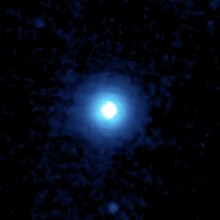
Infrared excess
One of the early results from the
Subsequent measurements of Vega at 193 μm showed a lower than expected flux for the hypothesized particles, suggesting that they must instead be on the order of 100 μm or less. To maintain this amount of dust in orbit around Vega, a continual source of replenishment would be required. A proposed mechanism for maintaining the dust was a disk of coalesced bodies that were in the process of collapsing to form a planet.[86] Models fitted to the dust distribution around Vega indicate that it is a 120-astronomical-unit-radius circular disk viewed from nearly pole-on. In addition, there is a hole in the center of the disk with a radius of no less than 80 AU.[88]
Following the discovery of an infrared excess around Vega, other stars have been found that display a similar anomaly that is attributable to dust emission. As of 2002, about 400 of these stars have been found, and they have come to be termed "Vega-like" or "Vega-excess" stars. It is believed that these may provide clues to the origin of the Solar System.[24]
Debris disks
By 2005, the
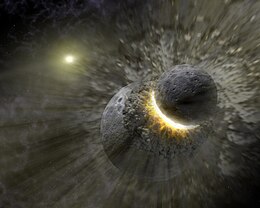
The inner boundary of the debris disk was estimated at 11″±2″, or 70–100 AU. The disk of dust is produced as radiation pressure from Vega pushes debris from collisions of larger objects outward. However, continuous production of the amount of dust observed over the course of Vega's lifetime would require an enormous starting mass—estimated as hundreds of times the
Observations, first with the
Possible planets
Observations from the
Determining the nature of the planet has not been straightforward; a 2002 paper hypothesizes that the clumps are caused by a roughly Jupiter-mass planet on an eccentric orbit. Dust would collect in orbits that have mean-motion resonances with this planet—where their orbital periods form integer fractions with the period of the planet—producing the resulting clumpiness.[95]

In 2003, it was hypothesized that these clumps could be caused by a roughly
Using a
Although a planet has yet to be directly observed around Vega, the presence of a planetary system cannot yet be ruled out. Thus there could be smaller,
From the perspective of an observer on a hypothetical planet around Vega, the Sun would appear as a faint 4.3-magnitude star in the Columba constellation.[note 5]
In 2021, a paper analyzing 10 years of spectra of Vega detected a candidate 2.43-day signal around Vega, statistically estimated to have only a 1% chance of being a false positive.[25] Considering the amplitude of the signal, the authors estimated a minimum mass of 21.9±5.1 Earth masses, but considering the very oblique rotation of Vega itself of only 6.2° from Earth's perspective, the planet may be aligned to this plane as well, giving it an actual mass of 203±47 Earth masses.[25] The researchers also detected a faint 196.4+1.6
−1.9-day signal which could translate to a 80±21 Earth masses (740±190 at 6.2° inclination) but is too faint to claim as a real signal with available data.[25]
Etymology and cultural significance
The name is believed to be derived from the
Among the northern Polynesian people, Vega was known as whetu o te tau, the year star. For a period of history it marked the start of their new year when the ground would be prepared for planting. Eventually this function became denoted by the Pleiades.[110]
The
In
In Zoroastrianism, Vega was sometimes associated with Vanant, a minor divinity whose name means "conqueror".[115]
The indigenous
In the
W. H. Auden's 1933 poem "A Summer Night (to Geoffrey Hoyland)"[121] famously opens with the couplet, "Out on the lawn I lie in bed,/Vega conspicuous overhead".
Vega became the first star to have a car named after it with the French
Notes
- ^ The polar temperature is around 2,000 K higher than at the equator due to the rapid rotation of Vega
- ISBN 978-0-387-98746-0.:
- Mbol = −2.5 log L/L☉ + 4.74,
bolometric magnitude, L is the star's luminosity, and L☉ is the solar luminosity. A Mbol variation of ±0.03 gives- Mbol2 − Mbol1 = 0.03 = 2.5 log L1/L2
- L1/L2 = 100.03/2.5 ≈ 1.028,
- ^ For a metallicity of −0.5, the proportion of metals relative to the Sun is given by
- .
ISBN 978-0792365525. - ^ The space velocity components in the Galactic coordinate system are: U = −10.7±3.5, V = −8.0±2.4, W = −9.7±3.0 km/s. UVW is a Cartesian coordinate system, so the Euclidean distance formula applies. Hence, the net velocity is
ISBN 978-1118881330.
- ^ The Sun would appear at the diametrically opposite coordinates from Vega at α = 6h 36m 56.3364s, δ = −38° 47′ 01.291″, which is in the western part of Columba.
The visual magnitude is given by π
See: Hughes, David W. (2006). "The Introduction of Absolute Magnitude (1902–1922)". Journal of Astronomical History and Heritage. 9 (2): 173–179.S2CID 115611984. - ^ That is, a vulture on the ground with its wings folded (Edward William Lane, Arabic-English Lexicon).
References
- ^ "Vega". Oxford English Dictionary (Online ed.). Oxford University Press. (Subscription or participating institution membership required.)
- ^ a b "Vega". Merriam-Webster.com Dictionary.
- ISBN 978-1-931559-44-7.
- ^ S2CID 18759600.
- doi:10.1086/420715.
- ^ Bibcode:2009yCat....102025S.
- S2CID 119417105.
- ^ Bibcode:2002yCat.2237....0D.
- ^ Bibcode:1967IAUS...30...57E.
- .
- ^ .
- ^ S2CID 13501650.
- ^ .
- ^ S2CID 251710497.
- ^ ISBN 978-0-486-21079-7.
- ^ Kendall, E. Otis(1845). Uranography: Or, A Description of the Heavens; Designed for Academics and Schools; Accompanied by an Atlas of the Heavens. Philadelphia: Oxford University Press.
- ^ Staff. "V* alf Lyr – Variable Star". SIMBAD. Retrieved October 30, 2007.—use the "display all measurements" option to show additional parameters.
- doi:10.1086/187418.
- ^ "Calculation by the Stellarium application version 0.10.2". Retrieved July 28, 2009.
- ^ ISBN 978-0-8018-6458-2.
- ^ a b Barker, George F. (1887). "On the Henry Draper Memorial Photographs of Stellar Spectra". Proceedings of the American Philosophical Society. 24: 166–172.
- ^ S2CID 533664.
- ^ S2CID 18898968.
- ^ S2CID 3450920.
- ^ S2CID 231693198.
- ISBN 978-0-7425-6296-7.
- ^ "IAU Working Group on Star Names (WGSN)". International Astronomical Union. Retrieved May 22, 2016.
- ^ "Bulletin of the IAU Working Group on Star Names, No. 1" (PDF). IAU Division C: Education, Outreach and Heritage (WGSN). July 2016. Retrieved July 28, 2016.
- ^ "IAU Catalog of Star Names". IAU Division C: Education, Outreach and Heritage (WGSN). August 21, 2016. Retrieved July 28, 2016.
- ^ ISBN 978-0-395-93431-9.
- ^ ISBN 978-0-486-23568-4.
- ISBN 978-0-521-64587-4.
- ISBN 978-0-7503-0917-2.
- ^ HIPPARCOS data. (The calculations exclude stars whose distance or proper motion is uncertain.) PDF[permanent dead link]
- ISBN 978-0-306-45790-6.
- S2CID 120286863.
- ^ "Spectroscopy and the Birth of Astrophysics". Tools of Cosmology. American Institute of Physics. Retrieved March 29, 2022.
- ISBN 978-0-19-850953-0.
- Bibcode:1993AAS...183.1710G. Archived from the originalon June 25, 2019. Retrieved February 5, 2012.
- ^ Gore, J.E. (1904). Studies in astronomy. London: Chatto & Windus. p. 42.
- ISBN 978-0-486-20210-5.
- ISBN 978-90-277-2810-4.
- ^ Anonymous (June 28, 2007). "The First Parallax Measurements". Astroprof. Retrieved November 12, 2007.
- Bibcode:1997A&A...323L..49P.
- ISBN 978-3-642-11601-8.
- ISBN 978-0-521-59889-7.
- doi:10.1086/190708.
- doi:10.1086/145697.
- ^ Walsh, J. (March 6, 2002). "Alpha Lyrae (HR7001)". Optical and UV Spectrophotometric Standard Stars. ESO. Archived from the original on February 9, 2007. Retrieved November 15, 2007.—flux versus wavelength for Vega.
- ^ McMahon, Richard G. (November 23, 2005). "Notes on Vega and magnitudes" (Text). University of Cambridge. Retrieved November 7, 2007.
- ^ doi:10.1086/130834.
- .
- ^ I.A., Vasil'yev; et al. (March 17, 1989). "On the Variability of Vega". Commission 27 of the I.A.U. Retrieved October 30, 2007.
- Bibcode:1985IAUS..111..225H.
- Bibcode:2007ASPC..364..305G.
- .
- ^ doi:10.1086/157000.
- S2CID 4330793.
- doi:10.1086/190603.—From pages 769–778: for stars in the range 1.75 < M < 2.2, 0.2 < Y < 0.3 and 0.004 < Z < 0.01, stellar models give an age range of (0.43–1.64)×109 years between a star joining the main sequence and turning off to the red giant branch. With a mass closer to 2.2, however, the interpolated age for Vega is less than a billion.
- ISBN 978-0-470-09220-0.
- S2CID 16201995.
- ISBN 978-0-521-56241-6.
- doi:10.1086/150603.
- ^ Richmond, Michael. "The Boltzmann Equation". Rochester Institute of Technology. Retrieved November 15, 2007.
- ISBN 978-0-226-10953-4.
- .
- Bibcode:1997A&A...318..215S.
- ^ Bibcode:1980SAOSR.389..195V.
- doi:10.1086/155220.
- S2CID 6021105.
- ^ Staff (July 26, 2009). "Magnetic Field On Bright Star Vega". Science Daily. Retrieved July 30, 2009.
- S2CID 53548120. A64.
- ^ Staff (January 10, 2006). "Rapidly Spinning Star Vega has Cool Dark Equator". National Optical Astronomy Observatory. Retrieved November 18, 2007.
- .
- S2CID 118213499.
- S2CID 15334093.
- Bibcode:1990BICDS..38..137R.—Entry for HD 172167 on p. 144.
- doi:10.1086/319000.
- .
- doi:10.1086/168279.
- ^ Majewski, Steven R. (2006). "Stellar Motions". University of Virginia. Archived from the original on January 25, 2012. Retrieved September 27, 2007.—The net proper motion is given by:
- ^ Bibcode:1998A&A...339..831B.
- ^ Moulton, Forest Ray (1906). An Introduction to Astronomy. The Macmillan company. p. 502.
- S2CID 59039482. A35.
- ISBN 978-1-85233-465-9.
- ^ doi:10.1086/162559.
- .
- .
- S2CID 15898697.
- S2CID 8291382.
- S2CID 2165054.
- ^ Girault-Rime, Marion (Summer 2006). "Vega's Stardust". CNRS International Magazine. Retrieved November 19, 2007.
- S2CID 4373502.
- ^ Staff (April 21, 1998). "Astronomers discover possible new Solar Systems in formation around the nearby stars Vega and Fomalhaut". Joint Astronomy Centre. Archived from the original on December 16, 2008. Retrieved October 29, 2007.
- S2CID 36818074.
- S2CID 10755059.
- ^ Gilchrist, E.; et al. (December 1, 2003). "New evidence for Solar-like planetary system around nearby star". Royal Observatory, Edinburgh. Retrieved October 30, 2007.
- S2CID 119542260.
- S2CID 55674804.
- S2CID 118553890. 82.
- S2CID 6461181. L130.
- doi:10.1086/131516.
- .
- ISBN 978-1-60206-086-9.
- ISBN 978-0-7873-1096-7.
- ^ Houlding, Deborah (December 2005). "Lyra: The Lyre". Sktscript. Retrieved November 4, 2007.
- S2CID 118597258.
- ^ Houtsma, M. Th.; et al. (1987). E. J. Brill's First Encyclopaedia of Islam, 1913–36. Vol. VII. E.J. Brill. p. 292.
- S2CID 84102853.
- ^ Smith, S. Percy (1919). "The Fatherland of the Polynesians – Aryan and Polynesian Points of Contact". The Journal of the Polynesian Society. 28: 18–20.
- ISBN 978-986-7332-25-7.
- ^ "天文教育資訊網" [AEEA (Activities of Exhibition and Education in Astronomy)] (in Chinese). July 3, 2006. Archived from the original on May 21, 2011. Retrieved January 6, 2019.
- ISBN 978-7-5085-0836-8.
- ^ Kippax, John Robert (1919). The Call of the Stars: A Popular Introduction to a Knowledge of the Starry Skies with their Romance and Legend. G. P. Putnam's Sons.
- ISBN 978-90-04-08847-4.
- S2CID 118454721.
- Bibcode:1857PPIVT...2..137S.
- ^ "ŚB 11.16.27". vedabase.io. Retrieved March 29, 2021.
- ISBN 978-0-87542-832-1.
- ISBN 978-90-04-09421-5.
- ^ "W. H. Auden – A Summer Night (to Geoffrey Hoyland)". Retrieved January 6, 2019.
- ^ Frommert, Hartmut. "Vega, Alpha Lyrae". SEDS. Archived from the original on October 24, 2007. Retrieved November 2, 2007.
- ^ Staff (May 20, 2005). "Launch vehicles – Vega". European Space Agency. Retrieved November 12, 2007.
- ^ Rumerman, Judy (2003). "The Lockheed Vega and Its Pilots". U.S. Centennial of Flight Commission. Archived from the original on October 18, 2007. Retrieved November 12, 2007.
External links
- Anonymous. "Vega". SolStation. The Sol Company. Retrieved November 9, 2005.
- Gilchrist, Eleanor; et al. (December 1, 2003). "New evidence for Solar-like planetary system around nearby star". Joint Astronomy Centre. Archived from the original on September 23, 2009. Retrieved November 10, 2007.
- Hill, Gay Yee; et al. (January 10, 2005). "Spitzer Sees Dusty Aftermath of Pluto-Sized Collision". NASA/Spitzer Space Telescope. Archived from the original on May 18, 2007. Retrieved November 2, 2007.

